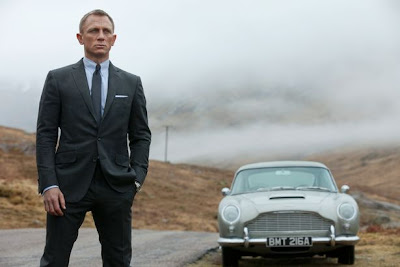First Shot:
Deakins does not waste any time. His first shot starts out completely out of focus. The only light is coming from behind Bond, he is not front lit at all. As James Bond walks down the hallway, he moves into focus. When he move completely into focus, he is lit with rich yellow light only capturing his eyes. This intriguing scene immediately pulls us into the world of James Bond (only the first 30 seconds are necessary to get the point).
Shanghai:
James Bond pursues an assassin to Shanghai, and then follows him to an upper floor of a skyscraper. Here Rodger Deakins takes advantage of the beautiful effect that can be found from reflections. The theme of reflections is something that Deakins plays with throughout the film, not just in this scene. He uses them a lot around the cell of the villain.
In Shaghai, he reflects the beautiful neon colors of the city throughout the scene. Bond and the assasin fight amongst the mirrors and the reflections (and the camera is never in the shot, despite the many mirrors). The skyscraper is bathed in neon blue, which casts much of Bond and his target into shadow. This comes into beautiful contrast with the room in the adjacent skyscraper. The focus on the shots are also incredibly well done (see image below).
Macau:
Bond follows a lead he received from the assassin to a seedy gambling ring in Macau. Here we have an insane lighting/color palette. Deakins and the production team on Skyfall put together incredible lanterns and dragons. These colors tend to be a very red/yellow/orange palette which contrasts really beautifully off the previous scene in Shanghai. These lights and colors are tied together with some really impressive crane shots and tracking shots. This then ties into some fireworks, which we can even see off of James Bond's face.
Scotland:
Deakins then contrasts both of these scenes off of Bond's home, Scotland. These scenes are very misty and washed out and Deakins uses a significant number of wide shots to really show case the beautiful landscape. The skill with which Deakins captures the landscape reminds me very much of the skill with which Peter Jackson captures the beauty of New Zealand with Lord of the Rings or the way JJ Abrams' TV series, Lost captured the landscape of Hawaii. The shots in Scotland start in the afternoon, progress through sunset and end with night shot. The precision that comes with having to light this transitional period of the day, is huge.
In addition, the lighting that came from having to deal with the mansion on fire. Once the mansion is on fire, and everyone is leaving it, they must be lit accordingly. For this shot Deakins had to bring in a significant number of Dino lights.
In post production the Dino lights are edited out and the flaming mansion is edited in. This was an incredibly strong climactic scene of the film.
I would highly recommend any of Deakins' work, but Skyfall was very strong in particular. The cinematography of Skyfall really deserved to be recognized in the form of an Academy Award.











No comments:
Post a Comment